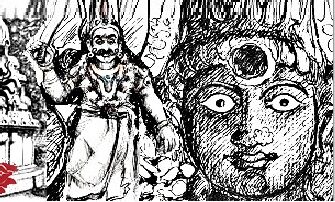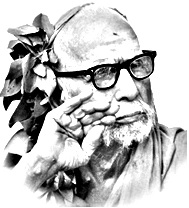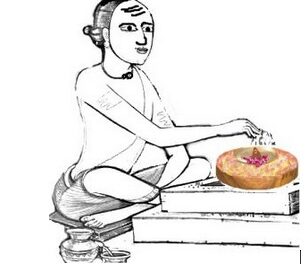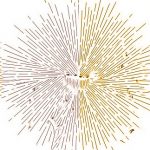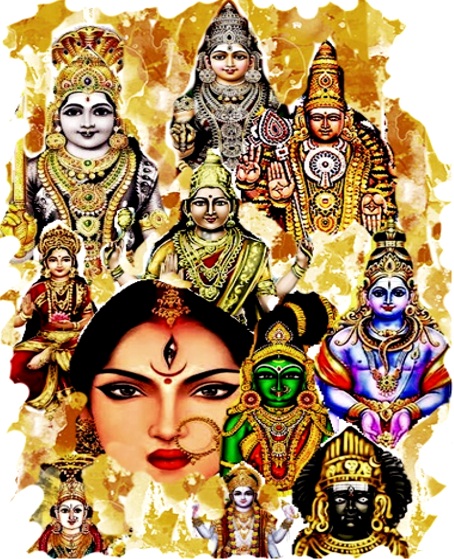 KULA DEVATHA OR TUTELARY/FAMILY DEITIES:
KULA DEVATHA OR TUTELARY/FAMILY DEITIES:
ORIGIN AND CONCEPT – 3
-Santhipriya-
201. At the same time the Kula Devatha or Tutelary/Family deity are also empowered to condone the punishment at later stage when the punished group ‘B’ continuously and sincerely prayed (without knowing the reasons for their sudden suffering) to their Kula Devatha or Tutelary/Family deity seeking relief from their problems. Upon satisfied with their sincere prayers, the Kula Devatha or Tutelary/Family deity could revoke the punishment given by the other divine, after due consultation with the divine which meted out the punishment. There are many such hidden norms and riders that curb the unilateral decisions of divines against fellow divine acts which remains beyond the scope of humans to clarify or understand.
202. In order to maintain the dignity and honour of the divines, Brahma has incorporated several such norms for the functioning of divines as he was aware that the entire fleet of Kula Devatha or Tutelary/Family deity are the same energy rays of ‘Supreme’ and therefore insulting or degrading the powers of the Kula Devatha or Tutelary/Family deity or infringing into others domain without due care would be tantamount to insulting their manifestation and the purpose for which they had been sent to the vast land.
203. All the above will illustrate that similar to the humans, the divines are also covered by certain norms in exercising their power and authority. All these have been done to show to the universe that the rule of law and justice is not limited to the mankind alone, but also applicable to the land of divines- Devaloga.
204. Like present day computer, Brahma may have possessed something similar to meticulously work out details of space in which specific sets of divines of various nature, angels or other souls would manifest. He has to monitor all acts meticulously including death and birth of souls sent by him to earth. He has to monitor the acts of divines etc, etc.
205. The Kula Devatha or Tutelary/Family and other divines will go and manifest only in the earmarked spot (spot does not mean a one square feet or square yard in size, but spread over few square meter area). Lord Brahma established this norm so that the deities and divines earmarked to a particular space need not get confused over the spots where they would manifest.
206. After manifesting in the area allotted, the deities ground their divine powers in those spots and get themselves enshrined on the same spot either in a shine or in open spaces in any form as they desire. No norms are stipulated for them and those divines were permitted to choose an appearance and form of their liking and convey the same to the humans either through their dreams or through those in trance to ensure that their statues or idols of worship are accordingly carved out by the people for enshrining in the spot where they get manifested.
207. One clear norm of Brahma was that wherever they manifested, that spot would get fully sanctified, grounded with divine energies of those who manifested there so that those who reach and pray in the spot could get invisible divine energy protective cover that will guard and guide them in many ways in their life.
208. Wherever the deities wanted to settle down as ordered, as said earlier, first they went and hid themselves in some place and informed about their places of hiding in the dream of the locals. After the locals reached the places, dug out the idols, they enshrined it in the same place which later became the shrine of the deity found inside the spot. Thereafter the folks began to visit the same temple and offered prayers and obedience.
209. Thus, they became the local temple for the locals who settled there . In this manner in each and every village, in some manner or the other, the deities who were destined to settle there, got themselves identified through the locals and in due course of time became Kula Devatha or tutelary/family deities to the locals there.
210. Can a divine who originally manifested in the space earmarked for them, again manifest in another space? This doubt arises because the same deity in the same form and name is found in many other temples spread in different spaces and the pundits in those temples say that one could offer prayers to the same deity in any of the temples where they have been enshrined.
211. Their contention is incorrect and not acceptable as per divine norm. At the same time, the divine norm does not prohibit offering prayers to the same deity in any of the temples spread in different other spaces other than the original place where they had manifested first.
212. Therefore, those who offer prayers to their Kula Devatha or Tutelary/Family in other temples will certainly receive the blessings in the normal manners bestowed to everyone, but the extent of blessing received would be far different from offering the prayers in the main temple, as the divine rays floating in the plane will be far different in other temples compared to the ones floating in the main temples where the deities were originally enshrined.
213. Let us study this by an example. Though many shrines exists for Aiyanar in different villages spread across Tamilnadu, the family of one Sundar worshipped one Aiyanar deity in Namakkal village (shown in blue colour) as their Kuladevatha.
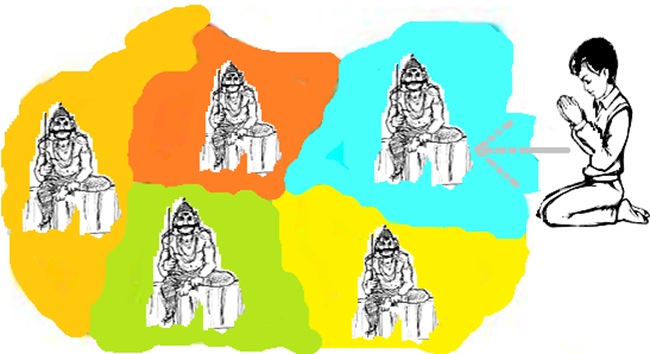
214. The other Aiyanar temples (same image and similar in all other aspects) existed in different other villages and towns (shown in other colours like yellow, orange, green, darkish yellow etc). Assume that the family of Sundar migrated to the dark yellowish shown village and continued to offer worship in the Aiyanar shrine treating it as his Kula Devatha. He completely stopped visiting the original village (Blue in colour) to offer prayers in his Kula Devatha shrine and continued to offer rituals and prayers only to the Aiyanar (in dark yellowish zone), treating the same as his original Kula Devatha (Aiyanar) .
215. Will his prayers get accepted by his Kula Devatha and his act endorsed as acceptable? The worshiper will no doubt get blessings of Aiyanar in the dark yellowish zone to the extent of his prayer and rituals, but he will not beget the blessings he will get to the same magnitude or degree from his Kula Devatha -Aiyanar seated in the blueish coloured village, nor will the rituals to Kula Devatha be accepted by his Kula Devatha- Aiyanar in bluish colored zone.
216. There is a small rider class in it. Sundar’s original Kula Devatha Aiyanar as worshipped by him in his native village (Bluish colored area) will however bless him fully and accept his rituals done to him in any other temples , in any other area, provided he or any of his family members continued to visit the original temple at least once in few years and offer prayers there because the divine power energies specific to his Kula Devatha lay grounded only in the prime temple spot (shown in Blue colour) where it had originally manifested and became the Kula Devatha of his family.
217. Even though the same deities in other temples may have been enshrined with full vedic rites and rituals which also draw divine energies (the rituals in fact are prayers seeking the divine energies to be ground there) of the same divines, the effect would be far different than the direct divine energy one may receive in the original place where they had manifested.
218. The direct divine energies float in the space where the divines had actually manifested and intrude into the bodies of those who go and offer prayers to their Kula Devatha there.This is what is seen as vibration as felt by many of the devotees while praying in the specified place. This does not mean that the family members whose Kula Devatha or Tutelary/Family deity which is shown in blue colored space, will not bless them if they prey to her in another temple as shown in yellow, dark yellow-, green- and orange- coloured areas. The Kula Devatha or Tutelary/Family deity will certainly understand their plight and protect and guide them provided the family members visit the main temple at least once or twice in their life span and offer prayers there. Unless this is done, the blessings of the Kula Devatha or Tutelary/Family deity would not be fully received by the devotees.
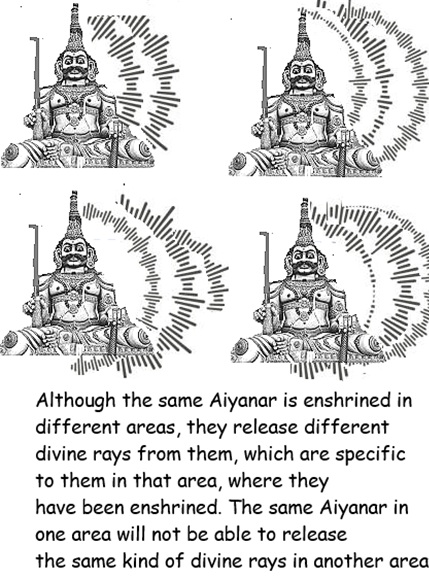
219. Sometimes the manifested divines (tutelary/family deities or other divines) also intruded into rocks or boulders or other lifeless objects (lifeless in outer appearance though each has their own invisible life in them) or remain in anthills for few years before they get traced or dug out. Once they enter into the rocks or boulders, those structures get infused with their divine energies and get reshaped matching with the appearance. Centuries later those statues get dug out as commanded by them, and enshrined in a shrine and worshiped there. Those temples where the original idols had thus been installed will have the powerful divine energies floating in the space which could be felt when one visit there. Such powerful divine energies released direct from the divine will not be available in other temples where the same divine idols were installed.
220. Deleted
221. Some of the divines never revealed their identity till they completed their penance on earth to get rid of their sins or reversal of their curses. Before returning to devaloga they ensured that the mortal body inside which they stayed during penance get buried below earth or sunk in rivers.
222. The mortal bodies of divines which lay buried deep inside the earth, became statues over period of several hundred years. Only after the bodies turned into statues, the divines informed the villagers of the same through some means, when they were dug out and few of them got enshrined in small shrines, rest placed under the trees in the rural areas and worshipped. Those deities thus enshrined became Kula Devatha to many families in those villages.
223. Some of those villages when turned into cities, the shrines in them slowly grew into magnificent temples during the reign of great kings who were eager to establish bigger temples when they heard of the powers of those deities. Thus, many of the temples which were initially consecrated with the statues and idols unearthed in many ways (Swayambhu or self-manifested idols) either became the Kula Devatha or Tutelary/Family deity to some of descendants of families or remained as temples of commoners. This is also the reason why the temples and Kula Devatha or Tutelary/Family deity as worshiped by most of the family members are still found in remote villages or difficult to reach terrains in forested areas, over the hill, fields, and other remote places.
224. Deleted as some of those contents have been merged with the text
225. We have to understand the basic fact that the exact period or the place where the temples or some kinds of worship shrines were constructed has not been conclusively established. But according to the historians, even during the vedic period, there were no shrines or temples, but during AD 1500 to AD 1600, few worship places similar to the temples were discovered in Afghanistan but not in India.
226. Similarly, though existence of temples were discovered in many parts of Asia such as Cambodia, Thailand, Iran, Pakistan, Malaysia, Singapore, and Africa surprisingly no such shrines or temples were seen in parts of India during that period nor idol worship noticed. However, in the much later part of vedic period few shrines where some idols have been worshipped in which some kinds of mantras have been chanted, were seen deep inside the villages. The idols in them were called guardian deities or Village deities. Most of such places of worship were found in make-shift small huts constructed with mud without top roof or were inside small caves as seen here and there.
227. The floating divine energies in those places where the idols of Kula Devatha or Tutelary/Family deity were dug out and enshrined embrace the body of the devotees like an invisible cover lasting for some period of time (the extent of period for which the said temporary protection lasts is not known) and block the entry of negative energies intruding into them. Perhaps this is the reason why the ancestors have laid out the principle of visiting the Kula Devatha or Tutelary/Family deity temples everyday if they stayed near the temple vicinity or at least visited once a year to retain the protective cover of divine energies on them.
228. Some may wonder when several thousands of folks have adapted a deity as their Kula Devatha or Tutelary/Family deity, how is it possible for the deity to personally reach each and individual to guide and guard them? The Kula Devatha or Tutelary/Family deity does not liaise with the individuals or the family directly. Every Kula Devatha or Tutelary/Family deity has fleets of invisible ganas to work on their behalf. Kula Devathas also release from each one of them several lakhs of divine rays to protect those who are under them.
229. Who are those ganas? Several demised forefathers and ancestors of each family members remain as Pithru ganas in Pithru Loga. The moment a family chooses their Kula Devatha or Tutelary/Family deity, immediately the Pithru ganas of those family are called upon from Pithru Loga by the Kula Devatha or Tutelary/Family deity to act as the liasoning ganas between those families and the deity. They in invisible form carry the messages and orders of the Kula Devatha or Tutelary/Family deity to their family lineage.
230. It is not only the Kula Devatha or Tutelary/Family deity’s command that the family receive thorough Pithrus, but also the commands of other divines prayed by the families are also sent through only through the Pithrus to ensure that they reach the proper person who could be identified only by their Pithrus. Since every family is guided by the Kula Devatha or Tutelary/Family deity through the Pithrus of their families, it is always said that the Pithrus are to be kept happy in Pithru Loga by performing necessary rituals meant to appease them.
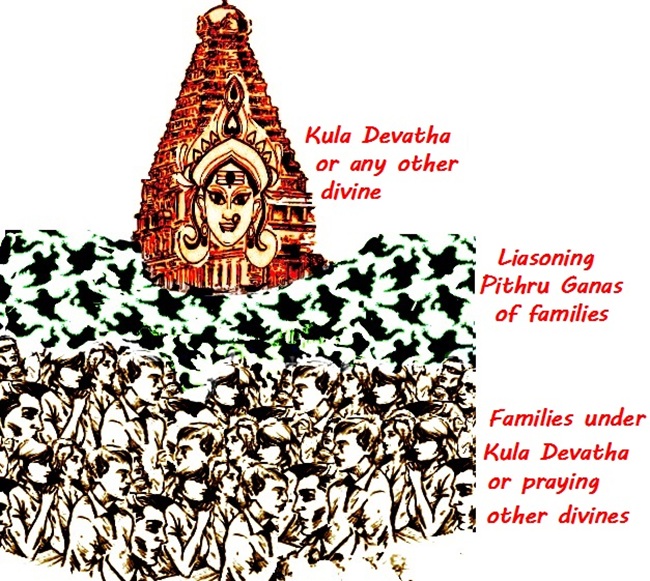
231. The divine principle has been that even if any one of the family members visit the main temple site of their Kula Devatha or Tutelary/Family deity to offer worship at least once in three to five years as a mark of respect to their family deity, that would be sufficient to absorb the invisible divine protective cover which gets automatically transferred to each and every one of their family members when they return back even if they remained in faraway places because the divine rays of pleased Kula Devatha or Tutelary/Family deity would travel to any length of distance to protect their members.
232. It does not mean that those who had not adapted the same deity as their Kula Devatha or Tutelary/Family deity but visit the same temple to offer worship are denied the protective cover. Anyone who visit the temple and offer prayers, too are provided positive energy rays in the form of blessings and protect them only for short period of time, but not to the extent of protective covers received by those who have adapted the said deity as their Kula Devatha or Tutelary/Family deity .
233. Similarly, when a family who held a specific deity as their Kula Devatha or Tutelary/Family deity if chose to ignore the worship of their family deity for any reason, the act would be construed as heinous crime and seven generations of the defaulter’s family would bear the brunt of the of the anger of their Kula Devatha or Tutelary/Family deity thus necessitating the family members of their successive generation to get rid of the sin with several forms of rituals or Vrath or prayers to appease the anger of their family deity.
234. Lastly, it is also surprising to note that over 90 % of the Kula Devatha or Tutelary/Family deities have emerged from rural spaces. As said earlier, their divine powers were also not lesser to the prime divines and were empowered to directly grant the favours for those who had adapted them as Kula Devatha or Tutelary/Family deity. At the same time, the very same tutelary deities were also empowered to answer the prayers of those who had no Kula Devatha or Tutelary/Family deities but accepted them as Ishta Devatha or general deity in that area. Again, while answering the prayers of general folks, the deities also ensure that the groups under their command were not affected in any manner.
235. It is seen that compared to divines manifested in the first three Yugas, more and more manifestations are seen during Kali Yuga. There is manifold increase of divine forces in the present Kali Yuga compared to those mentioned in Vedic scriptures, Ramayana and Mahabharata and many other texts in Hinduism.
236. Before activating and fill up the Universe with souls of several nature, Brahma may have meticulously worked out various aspects of the creations, the characteristics of each of the Yugas, several divines who would manifest in each of the Yugas including Kula Devatha or Tutelary/Family deity ,the time- frame for each of the manifestations in places assigned to them across the universe etc.
237. Does any norm exist as to how many Kula Devatha or Tutelary/Family deities and Village deities can manifest in a space? When Brahma sent divines to spaces, he may have ensured that for few hundreds of families, certain no of Kula Devatha or Tutelary/Family deities, Village deities and other guardian deities will be needed and accordingly he may have sent the ganas there to manifest in those forms. However, the Pundits were unable to explain details on them.
238. In the history of Kula Devatha or Tutelary/Family deity, a very important and interesting aspect is that the prime deities like Shiva, Vishnu and Parvathi have not been adapted as tutelary deities in their original form, but only their subordinate manifestations have been adapted as tutelary deities.
239. Who were the deities worshipped in the ancient period when divine worship commenced ? The deities, mainly female form of goddesses, associated with the well-being of the villages were either in violent posture or in benevolent ones and worshipped. There was no divisions such as Brahmins and non-Brahmins and everyone in the village worshipped the same deity in the same shrine or worship places which may have been either a Village deity, guardian deity or some unknown divine in the form of stones or spirits.
240. If we carefully analyse the deities worshipped as Kula Devatha or Tutelary/Family deity, they would find that around 85 % of the deities would be in female form- mostly emanations of Parvathi, hardly 10 % male- emanations of Vishnu or Shiva and 5 % major deities. Lord Vinayaga, Lord Hanuman, Lord Vishnu in their original form, Shiva in original form, Brahma, Saraswathi, Mahalakshmi or even Moon, Sun, Saniswarar and Krishna etc have not been adapted as their Kula Devatha or Tutelary/Family deity in their original form.
241. The present universe is dominated with many religions which have multiple sects in each. Naturally there may be several divine forces being worshipped by each religious sects. When looking at the different kinds of theism or belief in deities, the first big question we have to ask is this: how many deities are there?
242. The Yajurveda mentions that there were 33 Kotis i.e. 330,000,000 divines. (Ref: https://en.wikipedia.org/wiki/Hindu_deities). Another version mention the figure as 33 million Gods i.e. 33,000,000 (Ref: https://www.huffpost.com/entry/the-33-million-demigods-o_b_1737207).
243. It is quite possible that the above two figures may include several demi, semi and sub male and female divines, Deva ganas, Angels, Mohinis and Yoginis who were emanations from prime divines on many occasions. It may not have included the deities of other religions since the period in which the Yajur veda was written, there were no other religion except Hinduism.
244. However, both the figures on divines are contested by some analysts who state that the term 33 koti gods mentioned by the vedas have been misinterpreted as 330 million or 33 crore gods where as the 33 koti means 33 categories.
245. One of the analysts said ‘33 Crore Gods is a completely misinterpreted fact due to wrong translation of vedic Sanskrit by certain foreign scholars. The term ‘trayastrimsati koti’ mentioned in Atharvana Veda, Yajur Veda, and Satapatha-brahmana, is rightly translated as 33 Gods. The term koti in Sanskrit has two meaning, one is ‘type’ and the other is crore. (Ref : http://www.thenewsnow.co.in/newsdet.aspx?q=7208). Therefore, the word Koti might have indicated only the varieties of divines.
246. Another view aired is ‘Throughout recorded history, we can count between 8,000 and 12,000 gods who have been worshiped. But we can only count about 9 different types of gods (based on theological characteristics) who were worshiped. Each modern god also corresponds to one of these types, and 5 of them are of the Hindu type’. (Ref: https://lisbdnet.com/how-many-gods-are-there-in-the-world/).
247. However, the Anthropologists estimate that at least 18,000 different gods, goddesses, and various animals or objects have been worshipped by humans since our species first appeared. Today, it is estimated that more than 80 percent of the global population consider themselves religious or spiritual in some form. (ref: https://www.psychologytoday.com/us/blog/your-brain-food/202107/why-do-humans-keep-inventing-gods-worship) and worship divines of many nature.
248. It is however not known whether the village or guardian deities considered to be divine and worshipped in remote places have also been included or not in any of the recorded list or views aired. Certainly, no of divines worshipped cannot be either 33 crores, or 33 million or even stand at mere 33.
249. Since various versions create confusion, it would be better all of them be ignored and let the factual position be analysed from another angle.
250. As per the census in 2011 there were over 6,40,930 villages spread over the vast land of India alone (Ref: https://testbook.com/question-answer/how-many-villages-are-approximately-there-in-ind–5e1d7f7cf60d5d2d6cf1c8ee).
251. There is not even a single village where some divine is not worshipped. Most of the Village deities differ from one Village to the other. Therefore, even in a fair assessment we can assume that in India alone, 50% of the Villages could have had some form of divines- accounting to three lakhs i.e 3,00,000- who is worshipped by the locals. This is only an assumption.
252. When we read all versions in pre paras it will become clear that there may be multiple divines in many forms and appearances –say not less than a lakh – in this Universe and are worshipped by different people of different countries, different religious groups, ethnics and others.
253. See a case in Africa where many tribal exist and they worship several divines. Yoruba are probably the best-known West African ethnic culture in the world. In 1989, it was estimated that more than seventy million African and New World peoples practiced one form or another of Yoruba religion. Yoruba religions, inspired by them, are arguably the most widely dispersed West African religions, both in Africa and in the Americas.
254. Yoruba, one of the three major ethnic groups of Nigeria, have the same ethnic and cultural origins even though their geographic dispersal has located them in different modern states. They may also be the most theologically complex West African religions. It is estimated that the Yoruba have a pantheon of as many as six thousand deities which includes Village deities. (Ref: https://www.encyclopedia.com/history/news-wires-white-papers-and-books/deities-yoruba-and-fon-religions).
255. Look at another case. Zulu traditional religion in Southern Africa contains numerous deities commonly associated with animals or general classes of natural phenomena. They believe that the ancestors are believed to live in the spirit world unKulunkulu (meaning the greatest of the great) and are regarded as intermediaries between the living and the spirit world and they work hand in hand with God. They are similar to the Village deities. The Zulu were originally a major clan in what is today Northern KwaZulu-Natal, founded ca. 1709 by Zulu kaMalandela.
256. The ancient Greeks worshipped many gods, each with a distinct personality and domain. Greek myths explained the origins of the gods and their individual relations with mankind.
257. There are approximately 4,300 religions in the world. This information is according to Adherents, an independent, non-religiously affiliated organization that monitors the number and size of the world’s religions. (https://www.theregister.com/2006/10/06/the_odd_body_religion/) Even if one religion have their own divines the count could be not less than 4800, which may include village deities.
258. Therefore no one can give conclusive answer to how many divines are worshipped. All that we hear and read are based mere assumptions since in every country, multiple religions worship multiple divines of their own which includes Village deities. We can at best remain satisfied that there are multiple divines worshipped in the world whose count cannot be authenticated.
Next part—-References

